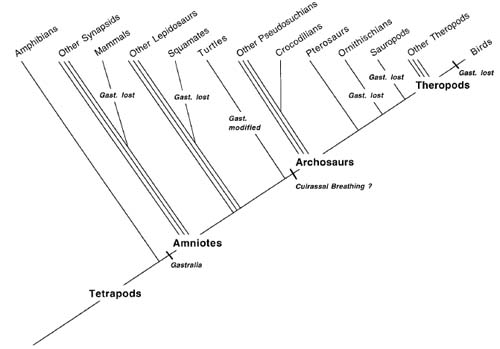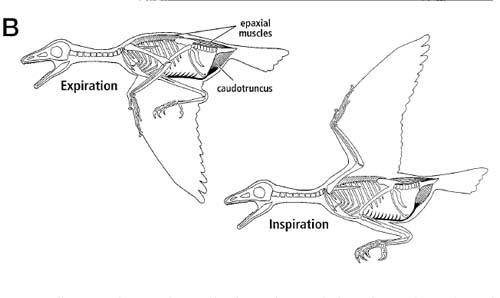Phylogeny of terapods showing distribution of gastralia and our hypothesis (denoted by question mark) for the origin of cuirassal breathing in archosaurs. |
|---|
Illistration of the mechanism of ventilation in the American alligator In alligators, expiration is produced by caudal rotation of the ribs and constriction of the abdominal cavity, which produce a cranial translation of the viscera. Constriction of the abdomen results from activity of the transversus abdominis muscle and the rectus abdominis muscle, the latter of which rotates the pubes dorsally. Inspiration is produced by cranial rotation of the ribs and caudal translation of the viscera. The viscera are pulled caudally by constraction of the diaphragmaticus muscle. The ischiopubic muscle increases the volume of the posterior abdomen by rotating the pubes ventrally. |
Illustration of the mechanism of ventilation in the pigeon During inspiration in pigeons the sternum rotates ventrally (ventrally pointing arrows) and activity of the longissimus dorsi muscle elevates the pelvic girdle on the dorsal vertebrae (dorsally pointing arrows). During expiration, activity of the suprapubic abdominal and infrapubic abdominal muscles depresses the pelvis and tail. |
|---|---|
Illustration of the prooposed cuirassal breathing mechanism in the theropod Deionychus antirrhopus The orientation and size of the pubes indicate that an ischiotruncus muscle was not present in maniraptoid theropods. For cuirassal breathing to work, a caudotruncus muscle would have to have been present |
Illustration of the prooposed cuirassal breathing mechanism in the early bird Sinornis santensis In early birds, inspiratory activity of the caudotruncus muscle would have required simultaneous activity of the epaxial muscles to stabilize the tail against ventral rotation. Note that if the cudotruncus muscle orriginated on the chevrons and pygostyle, as illustrated the digestive tract would have had to pass through the belly of the muscle to reach the vent. Alternatively, the caudotruncus muscle could have taken its origin fron the superficial myosepta of the tail, as it does in the American alligator. |




